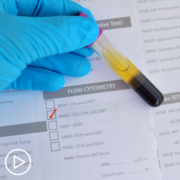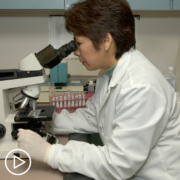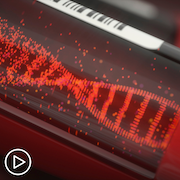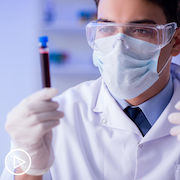What Is CAR T-Cell Therapy in CLL? from Patient Empowerment Network on Vimeo.
Chronic lymphocytic leukemia (CLL) patients have the option of CAR T-cell therapy in some cases. Watch as Dr. Nadia Khan from Fox Chase Cancer Center explains CAR T-cell therapy, access to the treatment, and which CLL patients are eligible.
See More from START HERE CLL
Related Programs:
Transcript:
Mary Leer:
Yolanda’s question is, what is CAR T-therapy and who is eligible?
Dr. Nadia Khan:
Thank you, Yolanda. This is a question that I get asked very frequently. CAR-T therapy is an exciting cellular therapy that has been FDA-approved in a number of lymphomas, and it is currently not FDA-approved for patients with CLL. So at this time, CLL patients can receive CAR-T therapy in the setting of a clinical trial only, and it is typically reserved for those patients who have progressed or relapsed after multiple lines of therapy and for whom there is no alternative therapy for consideration. Often, it is considered in the context of the clinical trial prior to the use of allogeneic stem cell transplant, because the results of allo transplant and CAR-T seemed to be fairly comparable. CAR-T therapy, however, is much better tolerated than allo transplant, both of these modalities are very rarely employed for our CLL patient today because of the very effective targeted therapies and immunotherapies that we have to use.
Mary Leer:
Dr. Khan, Chuck’s question is, what are the side effects of CAR T-cell therapy?
Dr. Nadia Khan:
Thank you, Chuck. For your excellent question, CAR-T-therapy is associated with two main types of side effects, one is Cytokine Release syndrome or CRS, which happens within the first two weeks of receiving CAR cells, and that can manifest as fevers, chills, a drop in blood pressure, shortness of breath, and the requirement of oxygen. When that happens to patients, there are medications that are given to help improve those cytokine-mediated events. Another major side effect with CAR-T therapy is neurotoxicity, which also happens within the first 14 days in some patients who receive CAR therapy, and that can manifest as anything from a headache to more concerning confusion, seizures and a coma. CRS happens commonly in patients who receive party therapy and is usually managed very successfully with anti-inflammatory therapies given intravenously in the hospital and can be used for patients even who get outpatient CAR-T therapy.
Dr. Nadia Khan:
When patients do suffer with neuro toxicities, intravenous therapies are also employed to combat that, and when necessary, patients might require escalation to an intensive care setting when these toxicities are very severe.
Mary Leer:
Dr. Khan, is CAR T therapy a cure for CLL?
Dr. Nadia Khan:
Thank you for your question, Bernard. CAR-T therapy has been curative for a minority of patients who have been treated with CARs on clinical trials, and unlike other lymphomas In CLL, there hasn’t been an FDA approval as yet for CAR-T therapy, and we are hopeful for that to change in the future as CARs are modified and may potentially become more effective at eradicating the CLL and hopefully resulting in better side effect profiles and patients who do receive CAR-T therapy, the majority of patients who have received CARs in CLL studies have not had durable remission, unfortunately.
Mary Leer:
Dr. Khan, what is conditioning therapy and why is it given prior to infusion of the CAR T cells?
Dr. Nadia Khan:
Thank you, Samuel. Conditioning therapy is a course of – a briefer course of chemotherapy that’s given just prior to CAR-T therapy, really to prepare the body in a way to receive the CARs, and it makes the CARs more effective when there has been a level of immunosuppression to allow the CARs to expand more freely after they have been re-infused into a patient.











